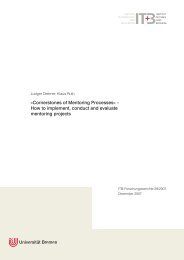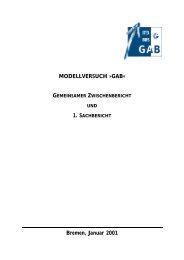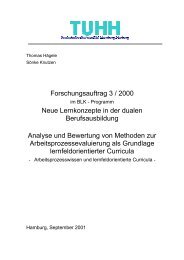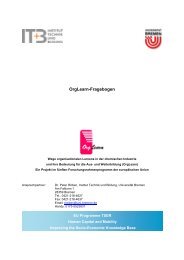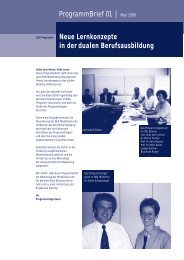VET Teacher Training in Australia: Preserving Australian VET ...
VET Teacher Training in Australia: Preserving Australian VET ...
VET Teacher Training in Australia: Preserving Australian VET ...
You also want an ePaper? Increase the reach of your titles
YUMPU automatically turns print PDFs into web optimized ePapers that Google loves.
(2004, p.2) proposition that social capital is the miss<strong>in</strong>g production factor <strong>in</strong> the pursuit of economic<br />
goals – i.e. <strong>in</strong> my and Libby’s terms, a person want<strong>in</strong>g and be<strong>in</strong>g able to make the most of what they<br />
know and can do <strong>in</strong> a manner which adds to organisational achievement and their pride‐<strong>in</strong> self.<br />
As Libby and I have found there is a ‘want’ with<strong>in</strong> the <strong>VET</strong> system for a graduate to possess more<br />
than just knowledge and skill (strong <strong>in</strong> social capital), it follows that the <strong>VET</strong> teacher who nurtures<br />
this must also have pride <strong>in</strong> self. It is somewhat mystify<strong>in</strong>g that this ‘want’ <strong>in</strong> respect of graduates<br />
doesn’t appear to be held by the system <strong>in</strong> respect of teachers. It seems unreasonable to expect<br />
professional commitment from teachers when their terms of employment are <strong>in</strong>creas<strong>in</strong>gly casual<br />
and the impression is given that they are seen as disposable.<br />
Tak<strong>in</strong>g note of the Harris et al (2009, p.29) observation that, <strong>in</strong> addition to hav<strong>in</strong>g been largely<br />
excluded from reform processes, <strong>Australia</strong>n <strong>VET</strong> teachers have been conceptualised as occupational<br />
rather than professional and, as a consequence, their preparation to teach and ongo<strong>in</strong>g professional<br />
development have been underm<strong>in</strong>ed. Maybe, this is at the heart of mov<strong>in</strong>g from rich pedagogical<br />
alertness and responsiveness to sett<strong>in</strong>g the Certificate IV <strong>in</strong> <strong>Tra<strong>in</strong><strong>in</strong>g</strong> and Assessment as the entry<br />
requirement (<strong>in</strong> addition to vocational competence) for a <strong>VET</strong> teacher.<br />
Note: In the <strong>Australia</strong>n Qualification Framework (AQF) a Certificate IV –Level 4 ‐ is described as<br />
‘Graduates at this level will have theoretical and practical knowledge and skills for specialised<br />
and/or skilled work and/or further learn<strong>in</strong>g’. When compared to the next level up – Diploma –<br />
‘Graduates at this level will have specialised knowledge and skills for skilled/paraprofessional<br />
work and/or further learn<strong>in</strong>g’, it is apparent that a <strong>VET</strong> teacher doesn’t even rank, at entry, as<br />
a paraprofessional. The question arises – What is the <strong>VET</strong> system understand<strong>in</strong>g, and valu<strong>in</strong>g,<br />
posture of be<strong>in</strong>g skilled as compared to be<strong>in</strong>g professional? It is worry<strong>in</strong>g, if the answer lies <strong>in</strong><br />
a view of <strong>VET</strong> teachers as be<strong>in</strong>g markedly of lesser fitness to facilitate learn<strong>in</strong>g when<br />
compared to a secondary school teacher who requires professional qualification at level 7 <strong>in</strong><br />
the AQF – Bachelor Degree ‐ ‘ Graduates at this level will have broad and coherent<br />
knowledge and skills for professional work and/or further learn<strong>in</strong>g’ (AQF).<br />
So where to?<br />
In my practice and research<strong>in</strong>g experience, <strong>VET</strong> outcomes as prescribed <strong>in</strong> the forego<strong>in</strong>g require a<br />
<strong>VET</strong> teacher to be ‘educationalist’ <strong>in</strong> orientation (Hughes & Hughes 2011; 2012). That is, the teacher<br />
br<strong>in</strong>gs commitment and passion to their facilitat<strong>in</strong>g role; and it is not exaggerat<strong>in</strong>g the occurrence to<br />
say that this is of an <strong>in</strong>fectious nature.<br />
I am particularly rem<strong>in</strong>ded of the truck driver who, hav<strong>in</strong>g <strong>in</strong>jured his back to the po<strong>in</strong>t where he had<br />
to f<strong>in</strong>d a new career, and was persuaded to reluctantly give be<strong>in</strong>g a social worker a try, was<br />
fortunate <strong>in</strong> com<strong>in</strong>g under the <strong>in</strong>fluence of a <strong>VET</strong> teacher who nurtured passion with<strong>in</strong> him to the<br />
po<strong>in</strong>t where he now regards hav<strong>in</strong>g the <strong>in</strong>jury as good fortune (Hughes 2008).<br />
In the ‘truck driver to social worker’ case the teacher was regarded by the student as highly<br />
professional and, accord<strong>in</strong>gly, deeply committed – presumably highly valued by the <strong>VET</strong> provider.<br />
However, this teacher was likely to have been labour<strong>in</strong>g under the uncerta<strong>in</strong>ty of cont<strong>in</strong>ued<br />
14




